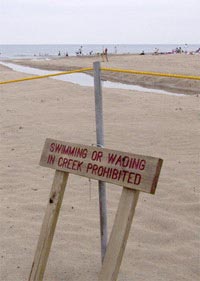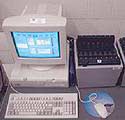Health and Environmental Effects Research
National Epidemiological and Environmental Assessment of Recreational Water (NEEAR)

EPA's NEEAR Water Study investigates human health effects associated with recreational water use.
Mission & Objectives
The National Epidemiological and Environmental Assessment of Recreational (NEEAR) Water Study is a collaborative research study between two laboratories of the U.S. Environmental Protection Agency and the Centers for Disease Control and Prevention that are investigating human health effects and rapid water quality methods associated with recreational water use. This study will provide real-time water quality measurements and help us better understand the link between water pollution, swimming at the beach, and peoples' health. A main goal of the NEEAR study is to determine how new ways of measuring water pollution can be used effectively to protect swimmers' health.
Water Quality Assessment
As part of this study, water quality is being assessed by EPA researchers
using new rapid, real-time (≤ 2 hours) methods, the new EPA monitoring protocol (See the EMPACT Study. PDF, 85pp., 2.8 MB), and the currently approved membrane filter method for enterococci (EPA Method 1600, mEI Agar). To obtain the most accurate measurements, the Agency will be
using state-of-the-art equipment and techniques to help assess the water quality of our
Nations recreational waters in real-time.

Quantitative Polymerase Chain Reaction (QPCR)

EPA Method 1600
Study Objectives
The objectives of the NEEAR Water Study are to:
- Evaluate the water quality at one or two beaches per year.
- Obtain and evaluate a new set of health and water quality data for the new rapid, state-of-the-art methods.
- Communicate the results to the US EPA Office of Water in support of their efforts to develop new state and federal guidelines and limits for water quality indicators of fecal contamination, so that beach managers and public health officials can alert the public about the potential health hazards before exposure to unsafe water can occur.
New NEEAR study publications and reports are available:
EPA conducted two epidemiological studies at POTW-impacted marine beaches in Fairhope, Alabama and Goddard, Rhode Island. The results from those sites were combined with epidemiologic results for a third location in Biloxi MS. The publication associated with this study is available in Environmental Health: http://www.ehjournal.net/content/9/1/66
- "Rapidly measured indicators of recreational water quality and swimming-associated illness at marine beaches: A prospective cohort study" Timothy J Wade, Elizabeth Sams , Kristen P Brenner , Rich Haugland , Eunice Chern , Michael Beach , Larry Wymer , Clifford C Rankin , David Love , Quanlin Li , Rachel Noble and Alfred P Dufour - Environmental Health 2010, 9:66doi:10.1186/1476-069X-9-66 Published: 31 October 2010
EPA conducted an epidemiological study in marine waters impacted by urban runoff in a temperate region to determine the relationship between faster approaches of measuring fecal indicator organisms and illnesses among swimmers. The site selected for this was Surfside Beach, South Carolina. EPA also conducted an epidemiological study in marine waters in a tropical region to determine the relationship between faster approaches to measure fecal indicator organisms and illnesses among swimmers. The site selected for this study was Boquerón Beach, Puerto Rico. The results of these studies are available in the EPA report referenced and attached below:
- EPA/600/R-10/168: "Report on the 2009 National Epidemologic and Environmental Assessment of Recreational Water Epidemiology Studies (NEEAR): Boquerón Beach, Puerto Rico, and Surfside Beach, SC of the paper published in Environmental Health" (PDF, 449pp., 16.78 MB)
Study Results
The NEEAR study's first major publication was released in September 2005. View the abstract or full article:
- Wade TJ, Calderon RL, Sams E, Beach M, Brenner KP, Williams AH, Dufour AP. Rapidly measured indicators of recreational water quality are predictive of swimming-associated gastrointestinal illness. Environ Health Perspect. 2006 Jan;114(1):24-8.
- Wymer LJ and Wade TJ. 2007. "The Lognormal Distribution and Use of the Geometric Mean and the Arithmetic Mean in Recreational Water Quality Measurement" in Statistical Framework for Recreational Water Quality Criteria and Monitoring (in press), John Wiley & Sons Ltd., Chichester
- Colford JM Jr, Wade TJ, Schiff KC, Wright CC, Griffith JF, Sandhu SK, Burns S, Sobsey M, Lovelace G, Weisberg SB. Water quality indicators and the risk of illness at beaches with nonpoint sources of fecal contamination. Epidemiology. 2007 Jan;18(1):27-35.
- Wade TJ, Calderon RL, Brenner KP, Sams E, Beach M, Haugland R, Wymer L, Dufour AP; High sensitivity of children to swimming-associated gastrointestinal illness: results using a rapid assay of recreational water quality. Epidemiology. 2008 May; 19(3):375-83.
- Molina, M. Evaluation Of Selected DNA-Based Technology in Impaired Watersheds Impacted by Fecal Contamination from Diverse Sources. U.S. Environmental Protection Agency, Washington, DC, EPA/600/R-07/123, 2007.
- Siefring S., Varma M., Atikovic E., Wymer L., and Haugland R.A. Improved real-time PCR assays for the detection of fecal indicator bacteria in surface waters with different instrument and reagent systems. J Water Health 2008: 6(2): 225-237.
